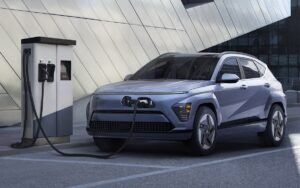Whether you do it at home or at public charging stations, here’s how long it takes to charge an EV — and what you can do to extend your range between charges

Charging an EV requires getting used to a new routine. Over 80 per cent of charging happens overnight and at home. But what happens when you need to charge out and about? Photo: Hyundai Canada
Whether you do it at home or at public charging stations, here’s how long it takes to charge an EV — and what you can do to extend your range between charges

This article is Sponsor Content presented by Hyundai Canada
Charging an EV requires getting used to a new routine and planning in advance. Over 80 per cent of charging happens overnight and at home. But what happens when you need to charge out and about?
Adjusting your expectations from a gas station that you may spend just a few minutes at to an EV charging station that could take enough time for you to go and have a quick meal is the first step.
EV charging doesn’t happen as quickly as filling up a gas car (yet), but Hyundai’s EV models are designed to facilitate an efficient charge so drivers can return to the road.
With high charging capacity vehicles and features to help extend and even recover range, we provide tips and tricks for getting the most out of your battery.
How many charging stations in Canada
The public charging network across Canada has approximately 9,873 chargers as of 2023. The government is targeting supporting 84,500 charging stations by 2029.
How long can an electric car sit without charging
While it’s recommended for an EV to be plugged in — particularly overnight when it is cold — an EV will be able to sit without being plugged in for long periods without any adverse impact on the battery.
What are the different types of chargers
Chargers are divided into three categories: Level 1, Level 2 and DC Fast Charger.
Each charger type dispenses electricity at a different speed. Level 1 and Level 2 chargers are most often found in home charging applications while fast Level 2 charging (50 kW and above) and DC Fast Charging are most frequently used by public charging networks that are servicing commuters.
What can affect charging speeds?
Vehicle charging capacity, temperature and number of vehicles charging impacts charging speeds — with the first and third items particularly relevant to public charging stations.
The Kona Electric has a charging capacity of up to 75-100 kW depending on the battery size, the Ioniq 5 has a charging capacity of 221 kW and the Ioniq 6 has a charging capacity up to 232 kW.
EV drivers will notice that charging speeds slowdown in hot or cold temperatures at home or at public charging stations. While those charging at public stations will also be impacted by how many other vehicles are charging at the same time. The more vehicles trying to charge simultaneously, the slower the charger will be.
What can improve range?
Preconditioning your EV is the first thing to do to improve range. Other range-saving technics include using regenerative braking, being conscious of driving style, not over-using cabin climate controls and using EV-specific tires.






